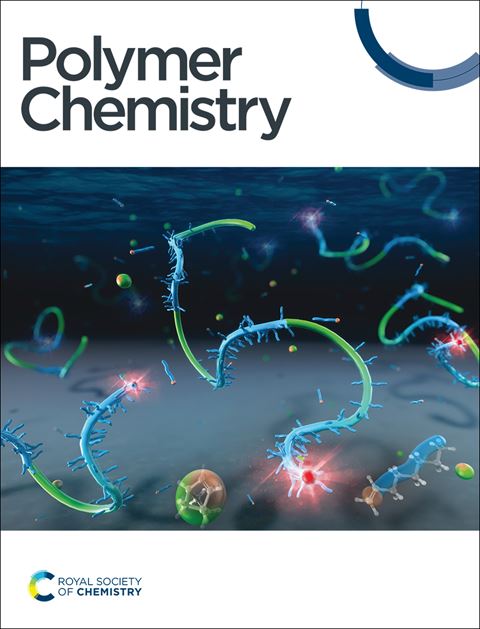Developing conjugated polymers with broad-band absorption covering visible and near-infrared regions for electrochromism†
IF 4.1
2区 化学
Q2 POLYMER SCIENCE
引用次数: 0
Abstract
Conjugated polymers containing donor (D) and acceptor (A) units exhibit intramolecular charge transfer (ICT), which results in lower bandgaps and facilitates a red shift of the absorption peaks. Utilizing the conjugated backbone structure and ICT mechanisms, several D–A-type polymers were designed and synthesized using thiophene, strong fused-ring thiophene donors (IDT or IDTT), ultrastrong acceptor units (benzobisthiadiazole derivatives (SNT) or benzothiadiazolo[3,4-g]quinoxaline (TQX)), and acceptor benzothiadiazole (TZ) as the building blocks for constructing broad-band absorption electrochromic polymers. The incorporation of SNT (or TQX) units into the polymer chain induces the near-infrared (NIR) modulation, while the combination of TZ units fulfils long-wave visible absorption for synergistic visible and near-infrared modulation of the polymers. Consequently, the synthesized polymers and derived electrochromic devices demonstrate ultra-broad electrochromism from 350 nm to 1000 nm with high optical contrast, swift switching response, and good stability, which show great application potential in smart windows.

开发覆盖可见光和近红外波段的共轭聚合物用于电致变色
含有给体(D)和受体(A)单元的共轭聚合物具有分子内电荷转移(ICT),并且通常具有较低的带隙,促进吸收峰向红色或近红外(NIR)区域的移动。利用共轭主链结构和ICT机制,以噻吩、强融合环噻吩给体(IDT或IDTT)、超强受体单元(苯并噻唑二唑衍生物(SNT)或苯并噻唑二唑[3,4-g]喹诺啉(TQX))和受体苯并噻唑(TZ)为构建单元,设计合成了几种新型D-A型聚合物,用于构建宽带吸收电致色聚合物。SNT(或TQX)单元加入到聚合物链中诱导近红外调制,而TZ单元的组合实现了聚合物的可见光和近红外(NIR)协同调制的长波可见光吸收。因此,合成的聚合物和衍生的电致变色器件具有350 ~ 1000 nm范围内的超宽电致变色,光学对比度高,开关响应快,稳定性好,在智能窗口中具有很大的应用潜力。
本文章由计算机程序翻译,如有差异,请以英文原文为准。
求助全文
约1分钟内获得全文
求助全文
来源期刊

Polymer Chemistry
POLYMER SCIENCE-
CiteScore
8.60
自引率
8.70%
发文量
535
审稿时长
1.7 months
期刊介绍:
Polymer Chemistry welcomes submissions in all areas of polymer science that have a strong focus on macromolecular chemistry. Manuscripts may cover a broad range of fields, yet no direct application focus is required.
 求助内容:
求助内容: 应助结果提醒方式:
应助结果提醒方式:


